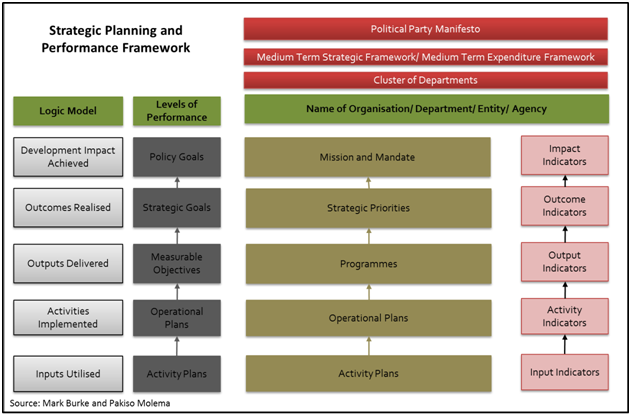Strategic planning in the public sector is different to strategic planning in the private sector in many ways, although some of the techniques developed in the private sector may be usefully applied.
Rather than focusing on building competitive advantage, our approach emphasise the building of specialist capacities to achieve the organisations policy goals and execute its mandate. An organisations specialist capacities should be observable in the same way that differences in the physique of a swimmer and that of a sprinter are observable.Public entities use strategic planning to cope with ambiguity and uncertainty in ways that marry organisational intention with the external environment. Strategy accounts for how the organisation defines the problems it needs to focus on and how it should channel its critical resources to this end. We view strategy as an emergent process that is embedded in organisational practice.
We have developed our strategic planning and performance monitoring framework over the last decade base on this conception of strategy in the public sector. The framework is a guide not a prison. It serves as a map that provides a flexible structure for the planning process in a way that allows organisations to start where they are most comfortable. It has been developed in line with the requirements specified by National Treasury.
The framework uses a Theory of Change approach with a means-end hierarchy that indicates the theoretical assumptions used in co-creating the strategic plan. It explicitly provides the means by which desired outcomes are to be achieved and indicates the relationship between the inputs, activities, outputs and planned outcomes.The strategic planning and performance monitoring method adopts a specific outcomes-focused approach.The benefit of an outcomes-focused approach is that it imposes astakeholder orientation logicon the organisation since the stakeholders that the organisation seek to impact are placed at the centre of the planning process.
The framework imposes a logic of collaboration on the organisation. Public organisations often do not have all the resources required to bring about the desired outcomes so that it needs to collaborate with others to do so. It imposes a logic of long-term planning on the institution since outcomes are frequently only achieved and observed over the medium to long-term. The framework also ensures alignment between the high-level outcomes and strategic priorities of government and the priorities, programmes and outputs of the organisation.